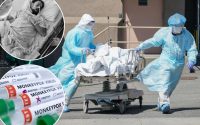How pregnancy can be breast cancer ‘double whammy’ for older moms
New research out of London suggests that human breast cells accumulate mutations as women age — and pregnancy can influence this process.
The Imperial College London study, published Wednesday in the journal Nature Communications, aimed to take a closer look at cellular and genetic changes within normal, healthy breast tissue to explain why breast cancer might develop after pregnancy.
“Our research delves into the genetic mysteries governing this risk,” Dr. Biancastella Cereser, lead author, said in a statement.
“Like other organs, we found that the human breast accumulates mutations with age — but also that pregnancy has an additional effect, meaning that older first-time mothers might have a higher chance of developing harmful changes in their breast cells than other women,” she continued.


The researchers noted that studies have shown that women who have their first child after age 24 have a 5% increase in risk of developing breast cancer every five years.
For this study, the team evaluated 29 women, grouping them by age and motherhood status: first-time mothers under 25, first-time mothers 35 to 55, and childless women 25 to 53.
The participants did not carry inherited mutations of the BRCA1 or BRCA2 genes, which can increase the risk for breast and ovarian cancer. They also did not have a history of using hormonal contraception.
The researchers found that first-time mothers 35 to 55 years old had larger and increased numbers of clonal patches of mutated cells in their breast tissue.
They also discovered that breasts will develop about 15 mutations a year in the epithelium tissue, where breast cancer predominantly arises.
They did note that most of the mutations were not harmful and posed no problem.


Cereser believes that as women age, because of the increase in mutated cells, there could be a “greater chance” for one or more of those mutations to develop in a gene that’s associated with cancer.
She noted that this may not be enough to cause cancer by itself, but if paired with pregnancy, it could be a “double whammy.”
Of course, there are other risks that can factor into a breast cancer diagnosis, including genetic mutations, dense breasts, a family history of breast cancer and reproductive history, according to the Centers for Disease Control and Prevention.
Symptoms of breast cancer can include a lump in the breast or underarm, an irritation or dimpling of the breast skin, nipple discharge that is not breast milk, like blood, and a change in the size or shape of the breast, per the CDC.
Meanwhile, the London researchers are hoping other scientists can build upon the findings of their study, which they say is the first to look at the entire genome of a healthy breast.
“Nobody has looked at the entire genome of the healthy breast before, let alone differentiating into groups of women who had given birth at different ages, as well as women who did not have any children,” Cereser said.
“I hope this study could be used as a resource for researchers looking at the genetics of healthy tissue in general, aside from the breast, and of course other breast cancer researchers, who could use the dataset of mutations we found as a ‘reference.’ ”


